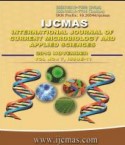


 National Academy of Agricultural Sciences (NAAS)
National Academy of Agricultural Sciences (NAAS)

|
PRINT ISSN : 2319-7692
Online ISSN : 2319-7706 Issues : 12 per year Publisher : Excellent Publishers Email : editorijcmas@gmail.com / submit@ijcmas.com Editor-in-chief: Dr.M.Prakash Index Copernicus ICV 2018: 95.39 NAAS RATING 2020: 5.38 |
Rice is the major staple food of the world’s population which contributes a vital role in global food security. Scarcity of water resources is a major threat for the higher water requiring crops like rice and agricultural production, as a whole. Henceforth, the present field experiment was conducted to study the rice cultivation with less water under alternate wetting and drying condition and to optimize the water depth. Field water tube being a promising tool to evaluate water depth both below and above ground level has been used for the study during kharif, 2017-18 on clay soils of the Agricultural College farm, Bapatla. The experiment was laid out in Randomized Block Design with seven treatments and three replications. The treatments included seven irrigation regimes viz., continuous submergence and six treatments with alternate wetting and drying where four treatments were installed with field water tubes. The results revealed that weekly application of 3 cm ponded water (T3) resulted in 47.6 % water saving as compared to continuous submergence, whereas treatments imposed with field water tubes were observed with 21.6 - 28.3 % less of continuous submergence. Among the four treatments with field water tubes, 5 cm submergence when water level receded 5 cm below ground level in the field water tube (T6) was found superior in terms of yield, water saving and water saving impact.
 |
 |
 |
 |
 |